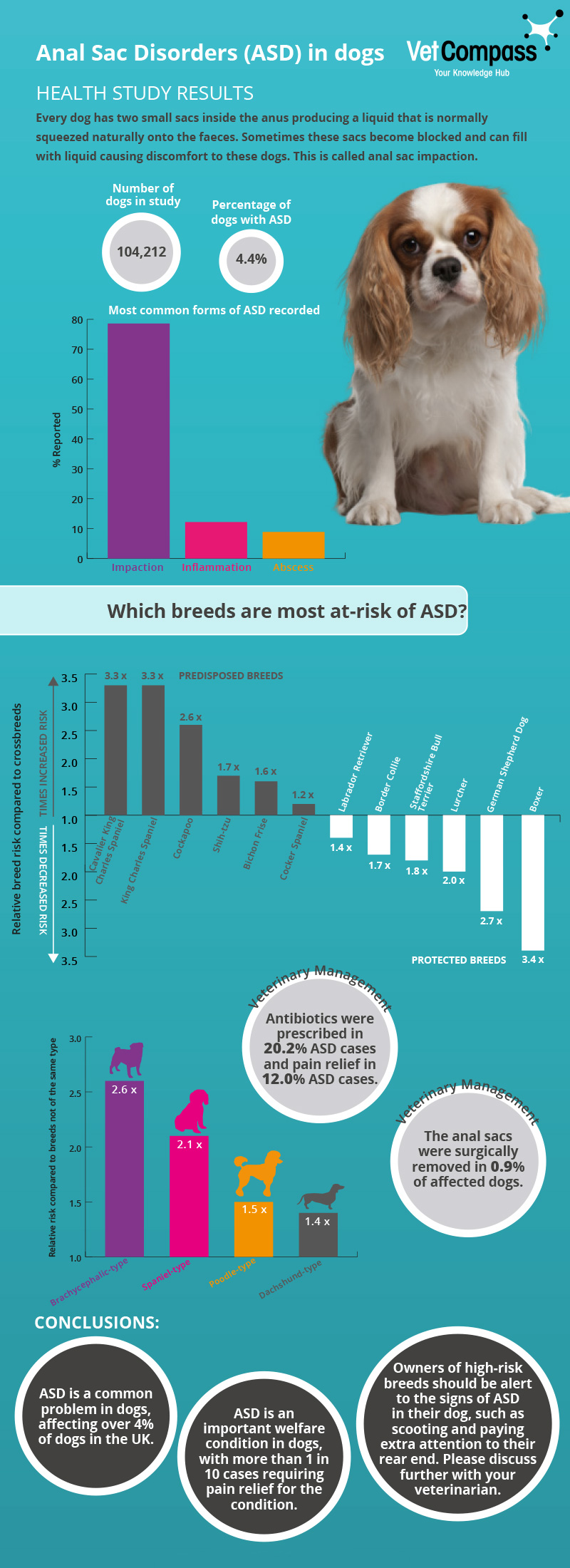Ground-breaking RVC research explores prevalence of anal sac disorders in dogs
A new study from the Royal Veterinary College (RVC) exploring the frequency and treatment of anal sac problems in dogs has been published in leading journal Veterinary Record. The study seeks to redress the lack of evidence-based information that has so far been published on the epidemiology and clinical management of non-neoplastic anal sac disorders (ASD).
This study, carried out within the RVC’s VetCompass™ programme, focused especially on identifying breeds with increased or reduced risk of anal sac disorders. The breeds at greatest risk of an anal sac disorder compared with crossbreeds included Cavalier King Charles spaniel, King Charles spaniel and Cockapoo. Conversely, breeds at reduced risk included larger breed dogs including Boxer, German Shepherd Dog and Lurcher. Interestingly, flat-faced (brachycephalic) breeds such as Shih Tzu had 2.6 times the risk for anal sac disorders compared to long-skulled breeds such as Border Collies. Spaniel-types, Dachshund-types and Poodle also showed increased risk for anal sac disease.
Even though ASD is associated with significant disease severity and is known to impair the quality of life of affected dogs, there is a scarcity of research on these kinds of problems. As a result, the criteria for the diagnosis of individual types of ASD are poorly defined. This is particularly surprising given that ASDs are consistently reported as one of the most common disorders affecting dogs under veterinary care.
This is the first study ever to report on anal sac disorders in dogs with a clear focus on which breeds are affected. The results will define knowledge gaps and guide future research into this neglected syndrome, helping veterinary practitioners, breeders and owners alike.
The study identified 2,372 anal sac disorder cases from a population of 104,212 dogs attending VetCompass™ participating practices during 2013.
Additional key findings include:
- Anal sac disorders affected 4.4% of dogs.
- Six breeds had increased risk of anal sac disorders compared with crossbred dogs: Cavalier King Charles Spaniel (x 3.31), King Charles Spaniel (x 3.30), Cockapoo (x 2.59), Shih-tzu (x 1.66), Bichon Frise (x 1.63) and Cocker Spaniel (x 1.24).
- Six breeds had reduced risk of anal sac disorders compared with crossbred dogs: Boxer (x 0.29), German Shepherd Dog (x 0.37), Lurcher (x 0.51), Staffordshire Bull Terrier (x 0.56), Border Collie (x 0.60) and Labrador Retriever (x 0.70).
- Flat-faced (brachycephalic) dogs had 2.62 times the risk of anal sac disorders compared with long-faced dogs.
- Spaniel-types had 2.09 times the risk of anal sac disorders compared with non Spaniel-types.
- Dachshund-types had 1.38 times the risk of anal sac disorders compared with non Dachshund-types.
- Poodle-types had 1.46 times the risk of anal sac disorders compared with non Poodle-types.
- The risks of anal sac problems were higher in older dogs.
- Insured dogs were 1.53 times more likely to have anal sac problems diagnosed than uninsured dogs.
- 20% of dogs with anal sac problems were prescribed antimicrobials while 12% were given pain relief.
- Anal sacs were surgically removed in under 1% of affected dogs.
- Dietary change was recommended in 8.18% cases and weight loss was recommended in 1.14% cases.
Dr Dan O’Neill, Senior Lecturer, Companion Animal Epidemiology, at the RVC, and author of the paper, said:
“During two decades in first opinion practice, anal sac problems in dogs were a routine daily presentation for me. However, when I searched the literature to find evidence on the best way to treat these dogs or even on which breeds were at most risk, there was almost no information available. It seemed back then that only problems that were severe enough to be referred to universities in large numbers were researched.
“As a result, vets in first opinion practice generally had to work out for themselves what seemed to be the best treatment in these cases. It is refreshing now to see research on common problems in dogs under first opinion veterinary care being reported. Owners and vets needs this evidence vitally.”
Dr Anke Hendricks, Associate Professor of Veterinary Dermatology at the RVC, and co-author of the paper, explained:
“Our understanding and management of anal sac disorders has not fundamentally changed since the 1970s, and there is still a lot we do not understand. By confirming the significance of anal sac problems in primary care practice in the modern dog population, this study now provides guidance for more targeted work on types of anal sac disorders, risk factors and best treatment practice.”
Anette Loeffler, Associate Professor of Veterinary Dermatology at the RVC and co-author of the paper, said:
“This study shines a spotlight on critically important area of veterinary practice: antibiotic usage. Twenty percent of dogs presenting with an anal sac disorder received antibiotics even though diagnostic criteria for anal sac infection or proof of efficacy of antibiotic treatment are lacking. At a time when antimicrobial resistance presents one of the biggest threats to human and animal health, this highlights an urgent need for further study of these disorders in order to improve dog welfare but also to help vets in making responsible antibiotic treatment decisions in the interest of public health.”
Bill Lambert, Head of Health and Welfare at The Kennel Club said:
“For most dog owners, anal sac problems aren’t exactly a common topic of conversation, but this research demonstrates that they certainly should be. They are one of the top three most commonly diagnosed canine disorders and are literally a pain in the backside for thousands of dogs each year.
“This research is invaluable in helping us identify the types of dogs most at risk of developing anal sac disorders. Ultimately, this will help to target owners that may need support in spotting the initial signs, as well as ways to treat affected dogs and ways to prevent it occurring in the future. The Kennel Club Charitable Trust helped to fund this fascinating research, and we hope that other researchers continue in this vein and aid further understanding of these conditions, helping to reduce this widespread problem.”
Research Reference
O’Neill DG, Hendricks A, Phillips JA, Brodbelt DC, Church DB, Loeffler A. Non-neoplastic anal sac disorders in UK dogs: Epidemiology and management aspects of a research-neglected syndrome. Vet Rec. 2021;00:e203. https://doi.org/10.1002/vetr.203.
Notes to Editors
For more information please contact:
- Jasmin De Vivo (Jasmin.DeVivo@plmr.co.uk) or rvc@plmr.co.uk
- Press Line: 0800 368 9520
About the RVC
- The Royal Veterinary College (RVC) is the UK's largest and longest established independent veterinary school and is a Member Institution of the University of London. It was the first in the world to hold full accreditation from AVMA, EAEVE, RCVS and AVBC.
- The RVC is the top veterinary school in the UK and Europe, and ranked as the world’s second highest veterinary school in the QS World University Rankings by subject, 2020.
- The RVC offers undergraduate and postgraduate programmes in veterinary medicine, veterinary nursing and biological sciences.
- In 2017, the RVC received a Gold award from the Teaching Excellence Framework (TEF) – the highest rating a university can receive.
- A research led institution with 79% of its research rated as internationally excellent or world class in the Research Excellence Framework 2014.
- The RVC provides animal owners and the veterinary profession with access to expert veterinary care and advice through its teaching hospitals and first opinion practices in London and Hertfordshire.



